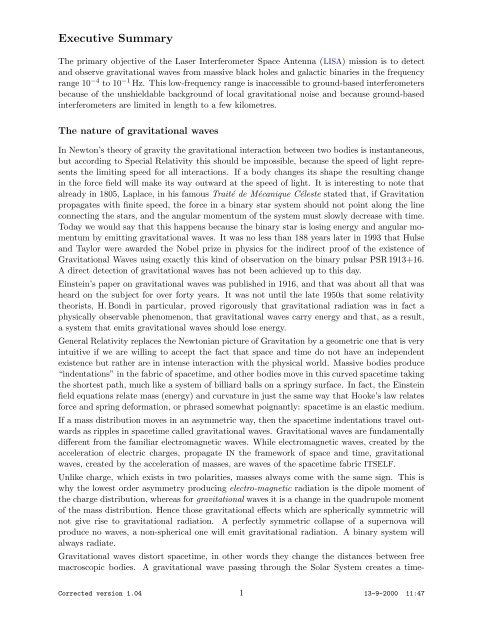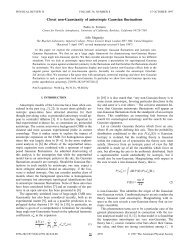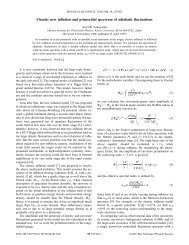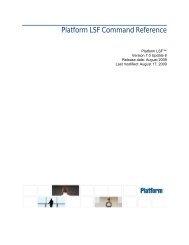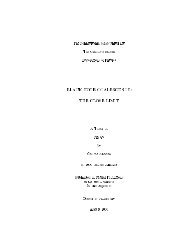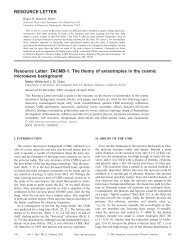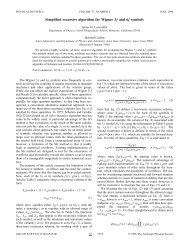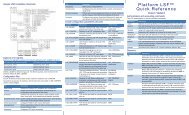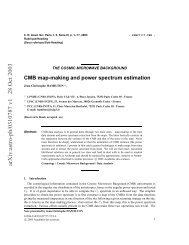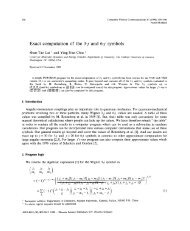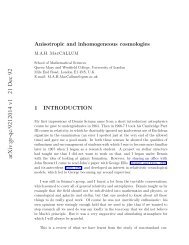LISALISA - iucaa
LISALISA - iucaa
LISALISA - iucaa
You also want an ePaper? Increase the reach of your titles
YUMPU automatically turns print PDFs into web optimized ePapers that Google loves.
Executive Summary<br />
The primary objective of the Laser Interferometer Space Antenna (LISA) mission is to detect<br />
and observe gravitational waves from massive black holes and galactic binaries in the frequency<br />
range 10 −4 to 10 −1 Hz. This low-frequency range is inaccessible to ground-based interferometers<br />
because of the unshieldable background of local gravitational noise and because ground-based<br />
interferometers are limited in length to a few kilometres.<br />
The nature of gravitational waves<br />
In Newton’s theory of gravity the gravitational interaction between two bodies is instantaneous,<br />
but according to Special Relativity this should be impossible, because the speed of light represents<br />
the limiting speed for all interactions. If a body changes its shape the resulting change<br />
in the force field will make its way outward at the speed of light. It is interesting to note that<br />
already in 1805, Laplace, in his famous Traité de Mécanique Céleste stated that, if Gravitation<br />
propagates with finite speed, the force in a binary star system should not point along the line<br />
connecting the stars, and the angular momentum of the system must slowly decrease with time.<br />
Today we would say that this happens because the binary star is losing energy and angular momentum<br />
by emitting gravitational waves. It was no less than 188 years later in 1993 that Hulse<br />
and Taylor were awarded the Nobel prize in physics for the indirect proof of the existence of<br />
Gravitational Waves using exactly this kind of observation on the binary pulsar PSR1913+16.<br />
A direct detection of gravitational waves has not been achieved up to this day.<br />
Einstein’s paper on gravitational waves was published in 1916, and that was about all that was<br />
heard on the subject for over forty years. It was not until the late 1950s that some relativity<br />
theorists, H. Bondi in particular, proved rigorously that gravitational radiation was in fact a<br />
physically observable phenomenon, that gravitational waves carry energy and that, as a result,<br />
a system that emits gravitational waves should lose energy.<br />
General Relativity replaces the Newtonian picture of Gravitation by a geometric one that is very<br />
intuitive if we are willing to accept the fact that space and time do not have an independent<br />
existence but rather are in intense interaction with the physical world. Massive bodies produce<br />
“indentations” in the fabric of spacetime, and other bodies move in this curved spacetime taking<br />
the shortest path, much like a system of billiard balls on a springy surface. In fact, the Einstein<br />
field equations relate mass (energy) and curvature in just the same way that Hooke’s law relates<br />
force and spring deformation, or phrased somewhat poignantly: spacetime is an elastic medium.<br />
If a mass distribution moves in an asymmetric way, then the spacetime indentations travel outwards<br />
as ripples in spacetime called gravitational waves. Gravitational waves are fundamentally<br />
different from the familiar electromagnetic waves. While electromagnetic waves, created by the<br />
acceleration of electric charges, propagate IN the framework of space and time, gravitational<br />
waves, created by the acceleration of masses, are waves of the spacetime fabric ITSELF.<br />
Unlike charge, which exists in two polarities, masses always come with the same sign. This is<br />
why the lowest order asymmetry producing electro-magnetic radiation is the dipole moment of<br />
the charge distribution, whereas for gravitational waves it is a change in the quadrupole moment<br />
of the mass distribution. Hence those gravitational effects which are spherically symmetric will<br />
not give rise to gravitational radiation. A perfectly symmetric collapse of a supernova will<br />
produce no waves, a non-spherical one will emit gravitational radiation. A binary system will<br />
always radiate.<br />
Gravitational waves distort spacetime, in other words they change the distances between free<br />
macroscopic bodies. A gravitational wave passing through the Solar System creates a time-<br />
Corrected version 1.04 1 13-9-2000 11:47


